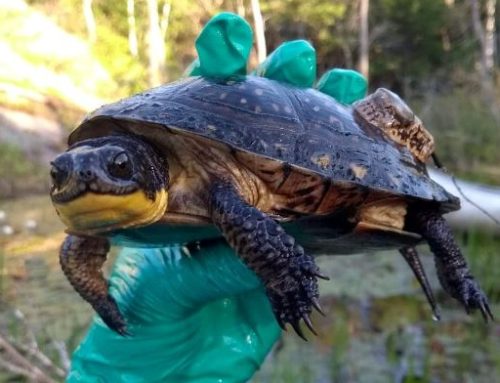Spring 2021
One of my favourite parts of spring is seeing everything outside starting to wake up. I love hearing the birds coming back from their migrations over winter, seeing the spring flowers popping up from the ground and all the new critters that were just born.
When the field crew is out searching for turtles in the spring, one thing we have to look out for and be careful not to disturb when walking through vernal pools is amphibian eggs. Vernal pools are forested areas that temporarily fill with water and provide protected breeding habitat for amphibians. This week, I was excited to get this underwater picture of some salamander eggs.

Salamander Eggs. Photo – Maureen Jackson
Salamander eggs are laid in the springtime and are surrounded by a thick jelly for protection. They are laid underwater and are attached to branches or leaves. They can be found in a variety of wetland habitats including vernal pools, ponds, and streams. Some can even be found in moist areas that are close to water, such as under rocks or logs.
Once the salamander eggs hatch, they are in what is called the larval stage, where they have a tail fin and gills, which makes them well adapted for life in the water. After the larval stage is complete, they will make their way onto land with newly developed legs. Once they reach their adult stage they will breed and have eggs of their own. Although these timelines vary between species, the salamanders will generally make their way to land around the end of summer.
Salamander eggs are very similar to frog and toad eggs, but can be told apart by the general shape that they are in. All three have individual embryos surrounded by a clear jelly egg. The photos below are general shapes of eggs from frogs, toads, and salamanders, but individual species can have unique adaptations that set them apart in the way they look or where they are laid. The frog egg masses are all individual eggs stuck together in one large clump. The toad eggs are similar but are organized in a string of individual eggs, which can look like long ropes in the water. The salamander eggs are most similar to the frog eggs, being in one big clump, but have that extra layer of jelly encasing all the eggs.

Frog Eggs. Photo – Jon Clayton, CVC

Toad Eggs. Photo – Steve Collins, CVC

Salamander Eggs. Photo – Credit Valley Conservation
I am looking forward to continuing the field season, both keeping up with our study turtles and seeing all the different aspects of wetland life!

Blanding’s Turtle hiding in the leaves of a vernal pool. Photo – Maureen Jackson
Photos
Clayton, J. 2019. Frog eggs. Retrieved from:
https://cvc.ca/conversations/whats-that-goo/frog-eggs/
Collins, S. 2019. Toad eggs. Retrieved from:
https://cvc.ca/conversations/whats-that-goo/steve-collins-toad-eggs/
Credit Valley Conservation. 2019. Salamander eggs at ponds on west side of Terra Cotta along
Bruce Trail (10). Retrieved from:
https://cvc.ca/conversations/whats-that-goo/salamander-eggs-at-ponds-on-west-side-of-
erra-cotta-along-bruce-trail-10/






